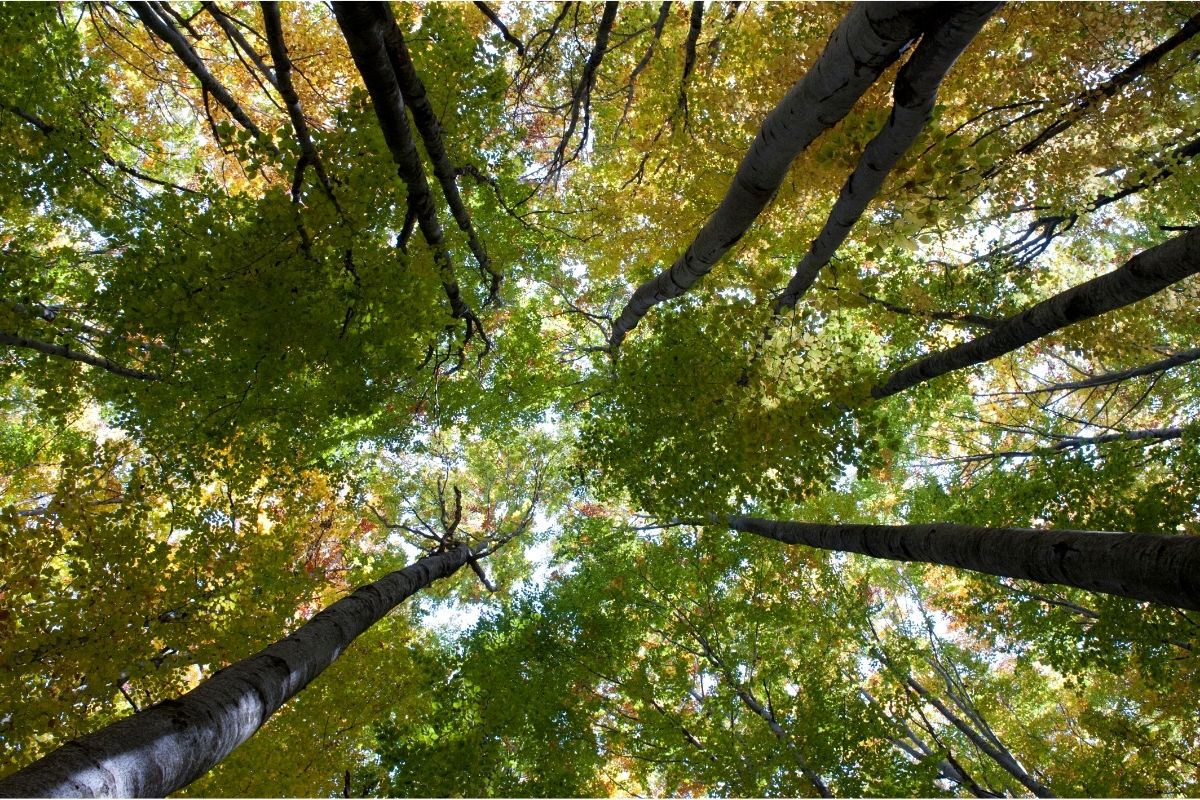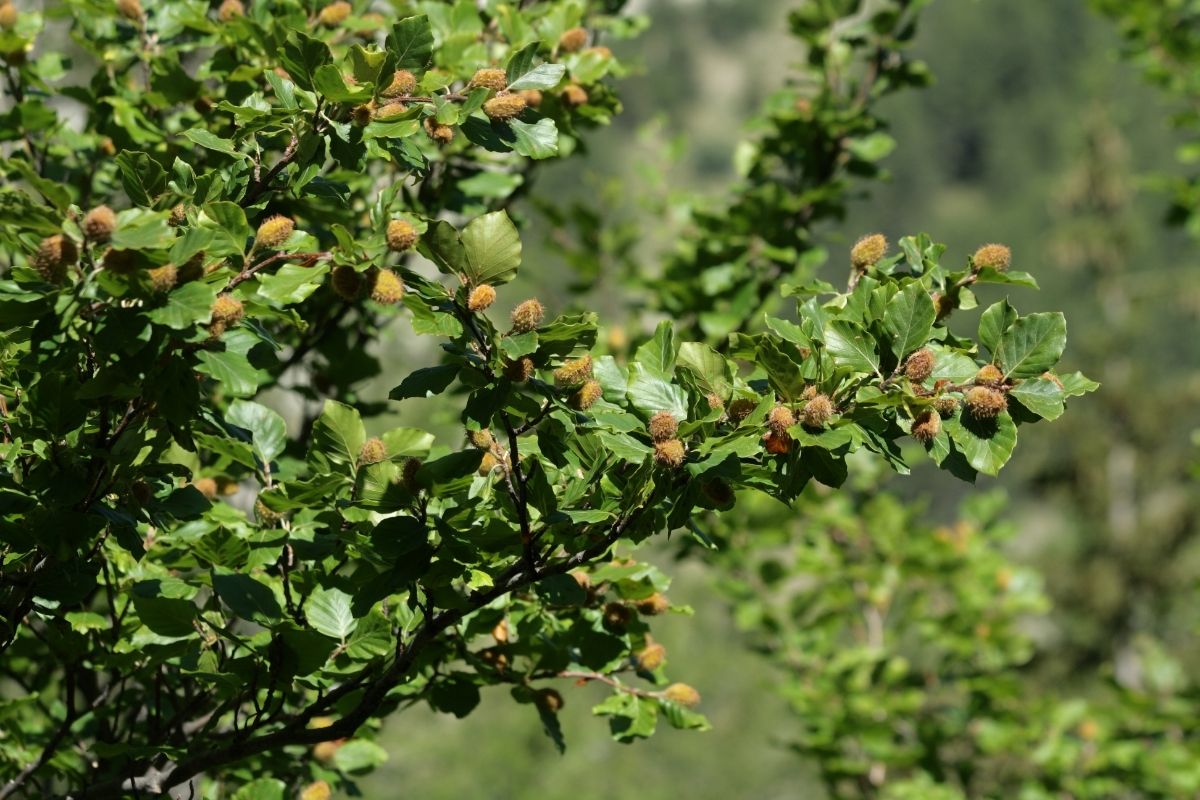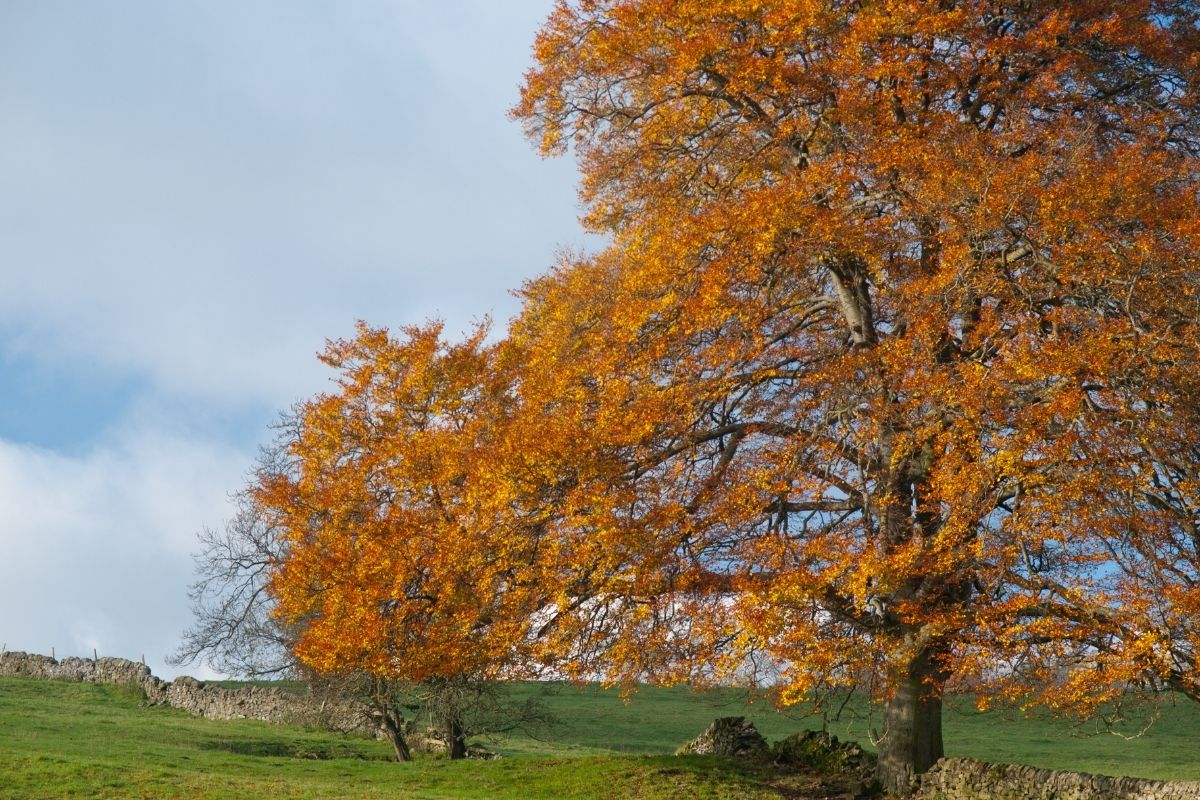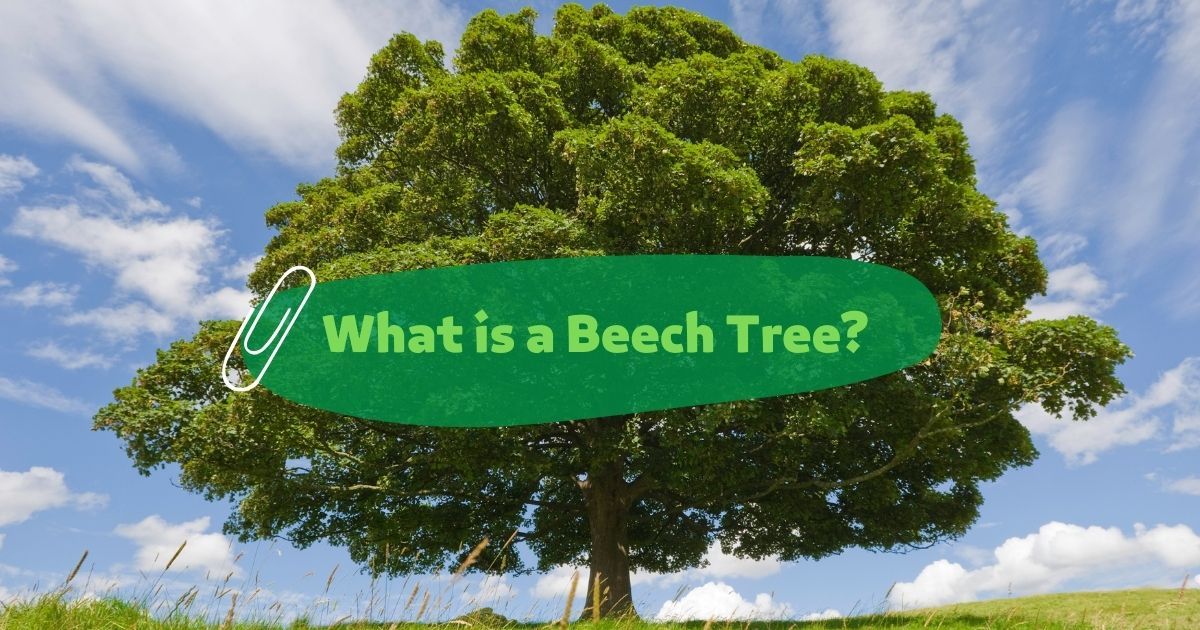Have you ever wondered, “what is a beech tree?”. There is no doubt that beech trees are one of the most beautiful trees, because of their low and wide branches, found in large, park-like landscapes.
The American beech tree has smooth gray bark with small brown cones, which many people mistake for pine cones. The leaves on beech trees turn yellow in autumn before falling off, and their nuts provide an important source of food for wildlife like squirrels and deer.
The American Beech tree’s scientific name is Fagus grandifolia. Let’s find out how they look like:
What Does a Beech Tree Look Like?
In American beech tree identification, you need to note that they are high-branching with smooth gray bark that often peels into thin sheets from the lower trunk. They have coarse twigs that are supported by a zigzag pattern of prominent grey colors.
The American Beech leaf has between 10 and 12 pairs of coarse, ovate-acute, yellow-green color. A small leaf usually attaches to the long petiole.
In the fall, beeches will have many yellow to red-orange candelabras that are small, and grow on slender peduncles.
Beech tree’s leaves are large ovals that are finely toothed at the tip and coarsely doubly toothed at the top, with a notch in between them. They are 5 to 10 centimeters long for single leaves and 6 to 15 centimeters for compound leaves. They are pinnately veined, with the end of each vein attached to a small, triangular scale (bifurcate), and their foliage is very dense.
The American Beech produces male and female flowers on the same tree. The male flowers are in small yellow catkins that grow from the axils of leaves which also produce pollen.
The female flowers form in clusters of three to ten, and their fruit is a large nut (in a cupule). The beech tree also has two types of seeds: small edible beechnuts and beechnuts.

Where do Beech Trees Grow?
Beech trees grow best at heights of between 150 and 1500 meters above sea level. They are native to Eurasia and the Northern Hemisphere in North America. They can be found in Asia Minor and in Eastern Europe, as far south as Albania. In Asia, they are found in the Himalayas, Japan, and Northern China.
So, where do beech trees grow? These trees grow on mountainsides, where the soil is thin and poor due to the rocky terrain. Beech trees also thrive in clearings of forests, but they do not like growing in deep shade. Therefore, they are most commonly found in mountainous regions because the mountains bring more light to the trees.
Beech trees like growing near streams and ponds. Their roots can grow deep enough to reach the water table, which is why they thrive near running waters or wet soils.
The History and Lore of the American Beech Tree
The American Beech tree is sturdy, but if you’re not careful, it will be your downfall. The first settlers to inhabit this land were thankful for plenty of fertile soil to grow their own food; however, once farming began, there was no room left at the table.
Every other tree branch would get cut off by migrating Passenger Pigeons that would perch on them until only stubs remained. They would then break loose entirely by the weight of all those birds combined.
The American beech tree has a long history and lore in North America. The Native Americans used the tree’s sap to make a syrup called “beechnut” or “Maumee.” The syrup was used as food, medicine, and paint. The nuts were also eaten and used for making baskets, dishes, and other household items.
American Beech Tree Facts
The American Beech is a large, graceful native tree. American Beech trees can spread their wide branches out across the ground without being too invasive. It’s excellent for those who want to have an extensive amount of space in their yard to enjoy the beauty of nature. l
In addition to this great characteristic, there is more that you should know about this species:
American Beech trees grow slowly, making them perfect if your goal is more sustainable growth over time. Also, during harsh winter months, their leaves hang on until new growth starts sprouting again, giving you some seasonal features all year long- not bad, right?
The tree typically grows to heights of 30-100 feet (9.14-30.48 m), with a trunk diameter of 2-3 feet (0.61-0.91 m). Their bark is smooth and gray, with slight ridges running horizontally along the trunk.
The leaves of the American beech measure 3-6 inches (2.54-15.24 cm) long and 2-4 (5.08-10.16 cm) inches wide. They are dark green above and lighter green underneath and have smooth margins. The leaves turn yellow, orange, and red in fall.
The flowers of American beech are small, inconspicuous, and grow in clusters of 2-5. They are pale yellow or greenish-white in color. The fruit of the American Beech is a small, hard nut that ranges in shades of light browns and black.

A General Description of Fagus Grandifolia
Fagus grandifolia is a sturdy, imposing tree with an upright oval or spreading crown. The bark on this North American native tree remains smooth as it ages and develops in size over time. They prefer well-drained soil that is rich in nutrients and acid.
Landscapes with this plant should never have standing water because they are intolerant when it gets too wet or compacted, leading them not to grow properly. Also, make sure your lawn does not come into contact too much, so you don’t kill everything underneath. Finally, these hardy giants should only take up space where there’s plenty of sunlight.
Diseases, Insects, and Other Associated Plant Problems
Several diseases, insects, and other associated plant problems can affect the American Beech tree. Some of the more common issues include beech blight, leaf spot, canker, scale, aphids, and borers.
Beech Blight
Beech blight is a fungal disease that affects the leaves and branches of beech trees. The fungus causes lesions on leaves that can enlarge and merge to form large blight areas. The blight may also cause branch dieback.
Canker
Canker is a fungal or bacterial disease that affects branches of beech trees. The fungus or bacteria causes dark cankers that grow on the trunk and branches of the tree.
Scale
Scale is a type of insect that attaches itself to the leaves and branches of Beech trees. The insects cause small raised bumps on the surface of the plant tissue, which decreases the tissue’s ability to transport nutrients and water properly. Severe infestations can lead to leaf drop and dieback of twigs and small branches.
Leaf Spot
Leaf spot (specifically anthracnose) is a common problem that affects Beech trees in North America, particularly when Sugar maple trees grow near each other. This disease affects both American Beech (Fagus Grandifolia) and Sugar Maple (Acer Saccharum).
The first sign of the disease is a small, water-soaked lesion on a leaf that will enlarge over time. If the leaves are not removed, they will wilt and fall off the tree. Infected branches may also die back.
Anthracnose can be controlled by removing and destroying infected leaves and branches in the spring before new growth begins. Fungicides can also be applied to the tree, but it is vital to select a fungicide labeled for use on Beech trees.
Aphids
Aphids are a type of insect that sucks sap from the leaves and stems of beech trees. The insects cause leaves to turn yellow or brown and stunt the tree’s growth. Severe infestations may lead to leaf drop.
Borers
Borers are a type of insect that infests the trunk and branches of beech trees. The insects drill into the wood of the tree and can cause damage to the bark and underlying tissues. Severe infestations may lead to the death of the tree.
Beech Scale
Beech scale is a rare problem for this tree. However, aphids on Beech trees are common, forming dense colonies that can cover small branches and leaves at any angle- even underneath them for protection against wind-germs.
The Harvester Butterfly
Feniseca Tarquinius feeds off these pesky insects from North Carolina’s only carnivorous insect; it’s no wonder why they’re so popular among naturalists who study butterflies here in America.
If you are experiencing any problems with your Beech tree, it is important to consult with a qualified arborist or plant health specialist for diagnosis and treatment recommendations. By properly caring for your Beech tree, you can help to ensure its long-term health and beauty.

Other Useful Information on the Fagus Grandifolia
Native Geographic Location and Habitat
Typically found along cool slopes and ravines in the eastern U.S. This plant is native to most of that region.
Size & Form
The American Beech tree is a common and iconic type of broadleaf evergreen tree. The sizeable open canopy makes it perfect for shade, but its wide-spreading branches make this tall, oak-like species great at loaning out their net with plenty to keep everyone cool. Leaf or Needle Arrangement- Size, Shape, and Texture
Alternate, oval-shaped leaves have toothed edges 2 to 5 inches (5.08-12.7 cm) long. The dark green color of these plants changes in the summer and becomes golden during fall.
Bark Color and Texture
The bark has a smooth, silvery-gray appearance.
Fruit, Cone, Nut, and Seed Descriptions
Beechnuts are sweet, meaty fruit that is covered with a prickly husk.
Flower Arrangement, Shape, and Size
Male beech tree flowers appear in clusters that hang down, while female ones are small spikes at the end of a tree. Male blossoms have an attractive yellow color, but they’re not showy like their female counterparts. This is because most people don’t want each individual blossom on their trees to be as noticeable and destructive from their surroundings, which makes sense, considering how many there might be.
Caring for Your American Beech Tree
The American beech is a beautiful, long-lived plant that prefers well-drained soil and acidic or neutral pH levels. It performs best in moderate climates with high humidity to slightly below average conditions for its range of needs (a little less than 300 years).
Loving to Leaf You!
Beech trees are one of the most common species in North America. They can be found from southern Canada to Virginia and as far west as Minnesota. Their bark is often a light gray color with dark brown stripes or spots on it, which helps make this tree easy to identify by sight alone.
Although they grow best in moist environments with good drainage, these hardy trees adapt well to almost any climate zone that humans inhabit because their roots can go deep into the ground for water when necessary.
